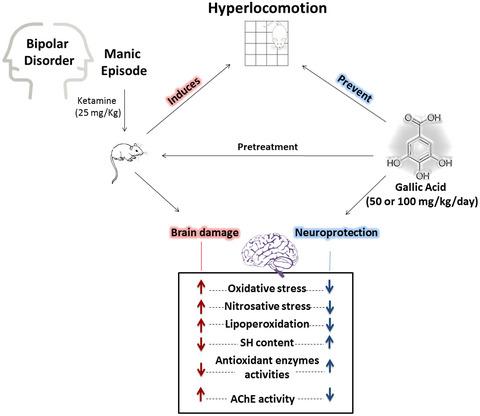当前位置:
X-MOL 学术
›
Int. J. Dev. Neurosci.
›
论文详情
Our official English website, www.x-mol.net, welcomes your
feedback! (Note: you will need to create a separate account there.)
Gallic acid protects cerebral cortex, hippocampus, and striatum against oxidative damage and cholinergic dysfunction in an experimental model of manic‐like behavior: comparison with lithium effects
International Journal of Developmental Neuroscience ( IF 1.7 ) Pub Date : 2021-01-17 , DOI: 10.1002/jdn.10086 Vânia Machado Recart 1 , Luiza Spohr 1 , Mayara Sandrielly Pereira Soares 1 , Bruna da Silveira de Mattos 1 , Natália Pontes Bona 2 , Nathalia Stark Pedra 1 , Fernanda Cardoso Teixeira 1 , Giovana Duzzo Gamaro 1 , Francieli Stefanello 2 , Roselia Spanevello 1
International Journal of Developmental Neuroscience ( IF 1.7 ) Pub Date : 2021-01-17 , DOI: 10.1002/jdn.10086 Vânia Machado Recart 1 , Luiza Spohr 1 , Mayara Sandrielly Pereira Soares 1 , Bruna da Silveira de Mattos 1 , Natália Pontes Bona 2 , Nathalia Stark Pedra 1 , Fernanda Cardoso Teixeira 1 , Giovana Duzzo Gamaro 1 , Francieli Stefanello 2 , Roselia Spanevello 1
Affiliation

|
Bipolar disorder is characterized by episodes of depression and mania, and oxidative stress has been associated with the observed neurochemical changes in this disease. We evaluated the effects of gallic acid on hyperlocomotion, acetylcholinesterase activity, and oxidative stress in an animal model of ketamine-induced mania. Rats were pretreated orally with vehicle, gallic acid (50 or 100 mg/kg), or lithium (45 mg/kg twice a day) for 14 days. Between days 8 and 14, the animals also received ketamine (25 mg/kg) or saline daily. On the 15th day, hyperlocomotion was assessed, following which the animals were euthanized, and brains were collected. Results showed that ketamine induced hyperlocomotion and caused oxidative damage by increasing reactive oxygen species levels, lipid peroxidation, and nitrite levels, and decreasing the total thiol content and the activities of catalase, superoxide dismutase, and glutathione peroxidase in the brain. Pretreatment with gallic acid and lithium prevented hyperlocomotion and brain oxidative damage. Further, ketamine increased the acetylcholinesterase activity in the hippocampus and striatum, whereas gallic acid and lithium ameliorated this alteration. Thus, gallic acid may provide effective protection against manic-like behavior by reducing oxidative stress and preventing cholinergic signaling dysfunction in the brain regions involved in emotion regulation.
中文翻译:

没食子酸在类似躁狂行为的实验模型中保护大脑皮层、海马和纹状体免受氧化损伤和胆碱能功能障碍:与锂效应的比较
双相情感障碍的特征是抑郁和躁狂发作,氧化应激与该疾病中观察到的神经化学变化有关。我们在氯胺酮诱发的躁狂症动物模型中评估了没食子酸对运动过度、乙酰胆碱酯酶活性和氧化应激的影响。大鼠用载体、没食子酸(50 或 100 毫克/千克)或锂(45 毫克/千克,每天两次)口服预处理 14 天。在第 8 天和第 14 天之间,动物还每天接受氯胺酮(25 毫克/千克)或生理盐水。在第 15 天,评估运动过度,随后对动物实施安乐死,并收集大脑。结果表明,氯胺酮通过增加活性氧水平、脂质过氧化和亚硝酸盐水平引起运动过度和氧化损伤,降低大脑中总硫醇含量和过氧化氢酶、超氧化物歧化酶和谷胱甘肽过氧化物酶的活性。用没食子酸和锂预处理可防止运动过度和脑氧化损伤。此外,氯胺酮增加了海马和纹状体中的乙酰胆碱酯酶活性,而没食子酸和锂改善了这种变化。因此,没食子酸可以通过减少氧化应激和预防参与情绪调节的大脑区域的胆碱能信号传导功能障碍来提供有效的保护,防止类似躁狂的行为。氯胺酮增加了海马和纹状体中的乙酰胆碱酯酶活性,而没食子酸和锂改善了这种变化。因此,没食子酸可以通过减少氧化应激和预防参与情绪调节的大脑区域的胆碱能信号传导功能障碍来提供有效的保护,防止类似躁狂的行为。氯胺酮增加了海马和纹状体中的乙酰胆碱酯酶活性,而没食子酸和锂改善了这种变化。因此,没食子酸可以通过减少氧化应激和预防参与情绪调节的大脑区域的胆碱能信号传导功能障碍来提供有效的保护,防止类似躁狂的行为。
更新日期:2021-01-17
中文翻译:

没食子酸在类似躁狂行为的实验模型中保护大脑皮层、海马和纹状体免受氧化损伤和胆碱能功能障碍:与锂效应的比较
双相情感障碍的特征是抑郁和躁狂发作,氧化应激与该疾病中观察到的神经化学变化有关。我们在氯胺酮诱发的躁狂症动物模型中评估了没食子酸对运动过度、乙酰胆碱酯酶活性和氧化应激的影响。大鼠用载体、没食子酸(50 或 100 毫克/千克)或锂(45 毫克/千克,每天两次)口服预处理 14 天。在第 8 天和第 14 天之间,动物还每天接受氯胺酮(25 毫克/千克)或生理盐水。在第 15 天,评估运动过度,随后对动物实施安乐死,并收集大脑。结果表明,氯胺酮通过增加活性氧水平、脂质过氧化和亚硝酸盐水平引起运动过度和氧化损伤,降低大脑中总硫醇含量和过氧化氢酶、超氧化物歧化酶和谷胱甘肽过氧化物酶的活性。用没食子酸和锂预处理可防止运动过度和脑氧化损伤。此外,氯胺酮增加了海马和纹状体中的乙酰胆碱酯酶活性,而没食子酸和锂改善了这种变化。因此,没食子酸可以通过减少氧化应激和预防参与情绪调节的大脑区域的胆碱能信号传导功能障碍来提供有效的保护,防止类似躁狂的行为。氯胺酮增加了海马和纹状体中的乙酰胆碱酯酶活性,而没食子酸和锂改善了这种变化。因此,没食子酸可以通过减少氧化应激和预防参与情绪调节的大脑区域的胆碱能信号传导功能障碍来提供有效的保护,防止类似躁狂的行为。氯胺酮增加了海马和纹状体中的乙酰胆碱酯酶活性,而没食子酸和锂改善了这种变化。因此,没食子酸可以通过减少氧化应激和预防参与情绪调节的大脑区域的胆碱能信号传导功能障碍来提供有效的保护,防止类似躁狂的行为。











































 京公网安备 11010802027423号
京公网安备 11010802027423号